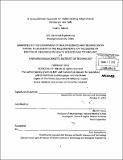A computational approach for understanding adaptation in vertebrate hair cells
Author(s)
Niksch, Paul D
DownloadFull printable version (33.58Mb)
Other Contributors
Harvard--MIT Program in Health Sciences and Technology.
Advisor
David P. Corey.
Terms of use
Metadata
Show full item recordAbstract
Vertebrate hair cells respond to mechanical stimuli with an inward current that is carried by extracellular cations through mechanically-gated transmembrane ion channels called transduction channels, located in the hair cell's specialized apical surface called the stereocilia. The current is characterized as having a rapid onset and adapting exponentially with a fast and slow time constant. The fast component is usually attributed to calcium binding directly to the transduction channels to promote channel reclosure. Myosin-1C, an unconventional myosin motor protein that is also modulated by calcium, adjusts the tension applied to the transduction channel to cause slow adaptation. Neither adaptation typically acts completely to restore the transduction current back to the baseline level. Recent evidence has suggested that the transduction channel is further away from myosin-IC than previously believed, creating a spatial separation that changes the nature of the calcium feedback. I developed a computational model to explore the motion of vertebrate hair cells simultaneously with calcium diffusion within the cell. The model is also capable of simulating many other experimental techniques that are commonly applied to hair cells. The results of the model suggest a fundamentally different viewpoint for understanding adaptation in vertebrate hair cells. Calcium can create unique responses from different transduction channels within the same hair cell. The implications of these findings help to explain the incompleteness of adaptation as well as implicate myosin-1C for fast adaptation as well as slow adaptation. In addition, groundwork for better understanding stereocilia-based amplification in the mammalian cochlea was developed. Experimental predictions were created to test these theories.
Description
Thesis (Ph. D.)--Harvard-MIT Program in Health Sciences and Technology, 2012. Pages 157 and 158 blank. Cataloged from PDF version of thesis. Includes bibliographical references (p. 150-156).
Date issued
2012Department
Harvard University--MIT Division of Health Sciences and TechnologyPublisher
Massachusetts Institute of Technology
Keywords
Harvard--MIT Program in Health Sciences and Technology.